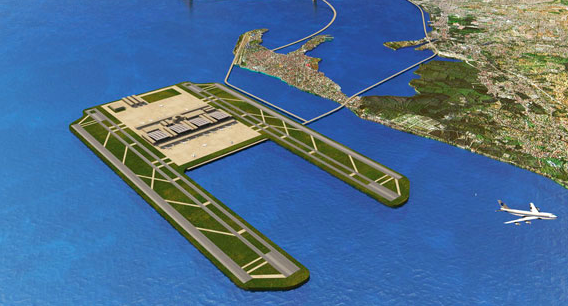The Sangley Point International Airport, a future alternative to the busy Ninoy Aquino International Airport (Naia) in Manila, remains in the picture as the Cavite provincial government submitted the full project study to the country’s economic planners last month.
The project, said to be aligned with the “One Belt, One Road” policy of the People’s Republic of China, aims to ease air congestion in Naia, where options for expansion are constrained by its location within the capital district of Metro Manila.
It will also provide a site for future air traffic growth without limits posed by the lack of available land.
The feasibility study, dated Dec. 12, 2018 and seen by the Inquirer, was prepared by a team of international and local experts including NATS and RDC from the United Kingdom and Hong Kong’s OTC.
The submission signaled the continued interest of the Cavite government to pursue the massive airport, which would rise on about 1,500 hectares of reclaimed land around a former US naval base in Sangley Point.
Based on the study, the Sangley Airport will cost about P508.5 billion. The first phase involves the opening of one runway by 2023. It has a design capacity of 25 million passengers a year.
More runways will be built in phases, going up to four runways that could serve 130 million passengers a year by 2050. The project will have a 25-year concession period, which can be renewed for another 25 years.
The proposal, made through a novel government to government approach, was initially met with skepticism within the Department of Transportation, which sought clarity on the legal framework and its funding sources.
Based on the feasibility study, the project will be set up as a “government-sponsored international joint venture and economic cooperation initiative.”
This means Sangley Airport will be financed by what it described as a Standard Airport Trust, which will be held by the province of Cavite and Philippine government agencies as trustors while investors will include state-owned financial institutions with CLSA acting as arranger.
The document mentions the Sangley Airport as an investment model intended as a “new exploration of the ‘One Belt, One Road’ business model of state-owned financial institutions of the PRC.
“The participation of Chinese-funded institutions in the construction of the Sangley Airport will help deepen the ties between the Philippines and China, especially deepen mutual trust and maintain regional political and economic stability,” a portion of the study read.
The Cavite government submitted the more than 500-page study to the investment coordination committee of the National Economic and Development Authority (Neda) last Dec. 17, a source with knowledge of the matter said. It would still require the approval of the Neda board, chaired by President Duterte.
Source: The Inquirer. Philippines

